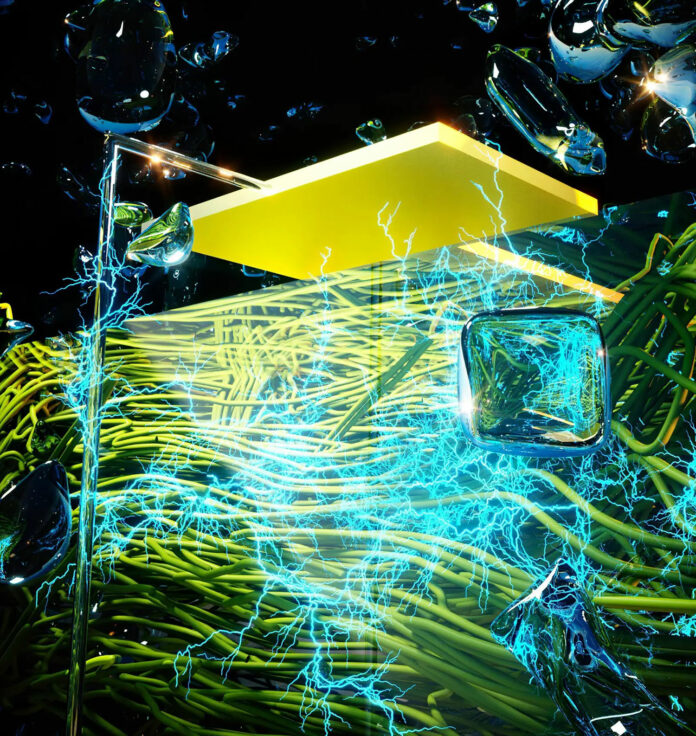Air humidity is a vast, sustainable reservoir of energy that, unlike solar and wind, is continuously available. However, the previously described technologies for harvesting energy from moist air are either not continuous or require unique material synthesis or processing that has hindered scalability and broad deployment.
Recently, engineers at the University of Massachusetts Amherst have shown that nearly any material can be turned into a device that continuously harvests electricity from humidity in the air.
“The air contains an enormous amount of electricity,” says Jun Yao, the paper’s senior author. “Think of a cloud, which is nothing more than a mass of water droplets. Each of those droplets contains a charge, and when conditions are right, the cloud can produce a lightning bolt – but we don’t know how to reliably capture electricity from lightning. What we’ve done is to create a human-built, small-scale cloud that produces electricity for us predictably and continuously so that we can harvest it.”
The heart of the man-made cloud depends on what Yao and his colleagues call the “generic Air-gen effect,” and it builds upon their previous research.
In 2020, Jun Yao and his team created a device they call an “Air-gen” or air-powered generator, with electrically conductive protein nanowires produced by the microbe Geobacter. Those protein nanowires could continuously pull clean energy out of the air by harvesting even small amounts of humidity. The Air-gen device relied on the chemistry of the protein nanowires, coupled with the fine pores between the nanowires within the film.
“What we realized after making the Geobacter discovery,” says Jun Yao, “is that the ability to generate electricity from the air – what we then called the ‘Air-gen effect’ – turns out to be generic: literally any kind of material can harvest electricity from the air, as long as it has a certain property.”
That property? “It needs to have holes smaller than 100 nanometers (nm), or less than a thousandth of the width of a human hair.” This is because of a parameter known as the “mean free path,” the distance one molecule of any substance can move before bumping into another molecule. When water molecules are suspended in the air, their mean free path is about 100 nm.
Researchers realized that they could design an electricity harvester based on this number. As with the previous research, the novel “air generator” (Air-gen) would be made from a thin layer of material filled with nanopores smaller than 100 nm, letting water molecules pass from the upper to the lower part of the material. Because each pore is so small, the water molecules would easily bump into the pore’s edge as they pass through the thin layer.
This means that the upper part of the layer would be bombarded with many more charge-carrying water molecules than the lower part, creating a charge imbalance, like that in a cloud, as the upper part increased its charge relative to the lower part. This would effectually create a battery that runs as long as there is any humidity in the air.
“The idea is simple,” says Yao, “but it’s never been discovered before, and it opens all kinds of possibilities.” The harvester could be designed from literally all kinds of material, offering broad choices for cost-effective and environment-adaptable fabrications. “You could image harvesters made of one kind of material for rainforest environments and another for more arid regions.”
As the humidity is ever-present, the harvester would run 24/7, rain or shine, at night and whether or not the wind blows. This solves one of the major problems of technologies like wind or solar, which only work under certain conditions.
Because air humidity diffuses in three-dimensional space and the thickness of the Air-gen device is only a fraction of the width of a human hair, many thousands of them can be stacked on top of each other, efficiently scaling up the amount of energy without increasing the footprint of the device. Such an Air-gen device would be capable of delivering kilowatt-level power for general electrical utility usage.
“Imagine a future world in which clean electricity is available anywhere you go,” says Yao. “The generic Air-gen effect means that this future world can become a reality.”
Journal reference:
- Xiaomeng Liu, Hongyan Gao, Lu Sun, Jun Yao. Generic Air-Gen Effect in Nanoporous Materials for Sustainable Energy Harvesting from Air Humidity. Advanced Materials, 2023; DOI: 10.1002/adma.202300748
